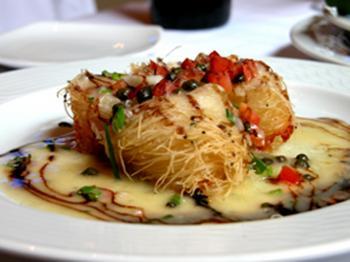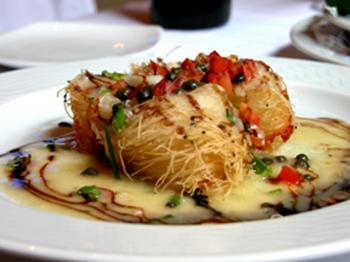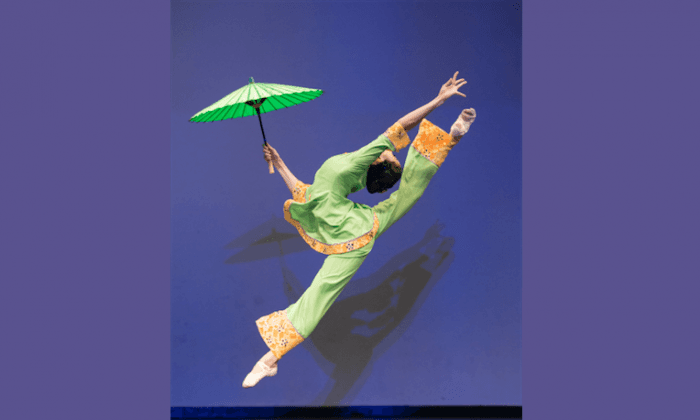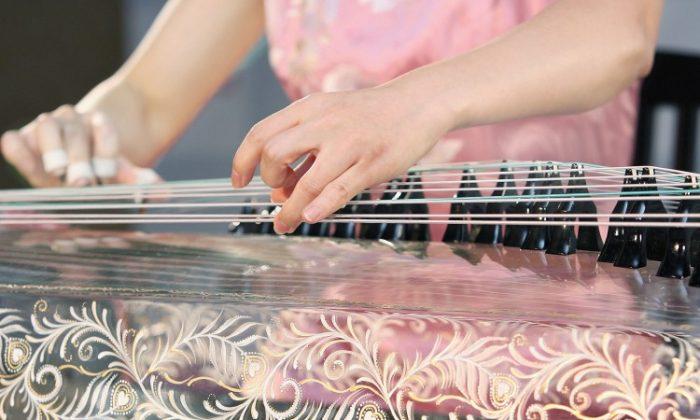Transforming dazzling Times Square into an ancient kitchen stadium of Chang’an, New Tang Dynasty’s third International Chinese Culinary Competition concluded to the roar of applause.
Aimed to revive traditional Chinese culinary arts and techniques, the competition attracted dozens of master Chinese chefs from 12 countries worldwide. Most of the chefs have as many as 20 to 40 years of cooking experience. Preliminary rounds were held in Taiwan and New York before the finalists came to Times Square, Oct 1, to battle for the win.
Prior to the competition, artists and engineers worked day and night to create a phenomenal scene: a Chinese architecture-inspired cooking stadium set up in New York City’s Times Square.
Wei Jane Chir, artistic director of the competition, drafted the scene according to ancient paintings.
“This culinary competition is going to be the best of its kind. It is not just a competition for chefs, but also a chance for us to showcase the culture of Tang Dynasty’s China. That’s why we try our best to make everything perfect so it can complement this grand event.”
Chang’an, now called Xi’an, was the capital of China during the most prosperous time of the Tang Dynasty (618–907) in terms of culture and economy.
The city was once home to the most renowned poets and artists. Chang’an was also the most desirable destination on the Silk Road, a historical trade route that connected traders of luxurious goods such as handcrafted art pieces, garments, and food from East, South, and Western Asia, the Mediterranean world, as well as North and Northeast Africa and Europe.
“Just like everyone wants to come to New York because New York is a place full of energy, Western people traveled through the Silk Road to go to Chang’an. Some of them wanted to learn [from China]; some wanted to show off their talents,” Chir said.
Costumes worn by servers at the competition were also exclusively designed. The style was worn by the palace girls and also by the guards as they accompanied the emperor when he was out hunting in the woods.
Aimed to revive traditional Chinese culinary arts and techniques, the competition attracted dozens of master Chinese chefs from 12 countries worldwide. Most of the chefs have as many as 20 to 40 years of cooking experience. Preliminary rounds were held in Taiwan and New York before the finalists came to Times Square, Oct 1, to battle for the win.
Chang’an in the Heart of New York
Prior to the competition, artists and engineers worked day and night to create a phenomenal scene: a Chinese architecture-inspired cooking stadium set up in New York City’s Times Square.
Wei Jane Chir, artistic director of the competition, drafted the scene according to ancient paintings.
“This culinary competition is going to be the best of its kind. It is not just a competition for chefs, but also a chance for us to showcase the culture of Tang Dynasty’s China. That’s why we try our best to make everything perfect so it can complement this grand event.”
Chang’an, now called Xi’an, was the capital of China during the most prosperous time of the Tang Dynasty (618–907) in terms of culture and economy.
The city was once home to the most renowned poets and artists. Chang’an was also the most desirable destination on the Silk Road, a historical trade route that connected traders of luxurious goods such as handcrafted art pieces, garments, and food from East, South, and Western Asia, the Mediterranean world, as well as North and Northeast Africa and Europe.
“Just like everyone wants to come to New York because New York is a place full of energy, Western people traveled through the Silk Road to go to Chang’an. Some of them wanted to learn [from China]; some wanted to show off their talents,” Chir said.
Costumes worn by servers at the competition were also exclusively designed. The style was worn by the palace girls and also by the guards as they accompanied the emperor when he was out hunting in the woods.
The Five Major Cuisines of China
In the competition, contestants were required to finish two to three dishes prepared in one of the five major Chinese cuisines. The cooking styles are named after their places of origin: Sichuan, Huaiyang, Cantonese, Dongbei (Northeastern), and Shandong.
After emperor Qin Shi Huang conquered adjacent kingdoms and unified China 2,000 years ago, more immigrants from the Southwest moved to Sichuan Province, in Southwestern China, and thus the unique cuisine of Sichuan was gradually formed.
Sichuan dishes are known for their spiciness. With 30 different cooking techniques such as stir-frying, oil-dipping, basting, and braising, and numerous kinds of spices such as garlic, hot pepper, and peppercorns, Sichuan cuisine has 24 basic flavors, and each represents a different type of “spiciness.”
Chefs of Sichuan cuisine also uses peppercorn to add a touch of numbness. While most spicy food leaves your mouth thirsty and dry after a few tries, Sichuan dishes give a bit of the tingling sensation that only makes you crave more.
After emperor Qin Shi Huang conquered adjacent kingdoms and unified China 2,000 years ago, more immigrants from the Southwest moved to Sichuan Province, in Southwestern China, and thus the unique cuisine of Sichuan was gradually formed.
Sichuan dishes are known for their spiciness. With 30 different cooking techniques such as stir-frying, oil-dipping, basting, and braising, and numerous kinds of spices such as garlic, hot pepper, and peppercorns, Sichuan cuisine has 24 basic flavors, and each represents a different type of “spiciness.”
Chefs of Sichuan cuisine also uses peppercorn to add a touch of numbness. While most spicy food leaves your mouth thirsty and dry after a few tries, Sichuan dishes give a bit of the tingling sensation that only makes you crave more.
The second one, Huaiyang cuisine, was named after several major cities along the Yangtze River. Huaiyang dishes require a meticulous preparation process, as the emphasis of the cuisine is to balance the rich flavor and pure taste of the ingredients. Because of the geographic location of the Huaiyang region, the cuisine combines the richness and savory quality of Northern dishes with the tenderness and mildness of Southern dishes.
Cantonese cuisine’s most famous food fare is the delicious Dim Sum, with its transparent skins and colorful fillings. Chefs of Cantonese cuisine are known for their creativity. They adjust flavors of the dishes constantly—according to climate, seasonal changes, and time of day the dish is served.
Contestant Jeff Xu from Michigan, who cooked Cantonese dishes for the competition, said: “To cook Chinese food, one is required to have a solid grasp of nature and its changes. Only then will one know what materials are the best to pick for the time being.”
Most Cantonese soups have a preparation time of as long as 5 to 6 hours, and each has a different function. For example, papaya bone soup, favored by ladies, is good for the skin.
Cantonese cuisine’s most famous food fare is the delicious Dim Sum, with its transparent skins and colorful fillings. Chefs of Cantonese cuisine are known for their creativity. They adjust flavors of the dishes constantly—according to climate, seasonal changes, and time of day the dish is served.
Contestant Jeff Xu from Michigan, who cooked Cantonese dishes for the competition, said: “To cook Chinese food, one is required to have a solid grasp of nature and its changes. Only then will one know what materials are the best to pick for the time being.”
Most Cantonese soups have a preparation time of as long as 5 to 6 hours, and each has a different function. For example, papaya bone soup, favored by ladies, is good for the skin.
Many associate Chinese cooking techniques with “cooking over flames.” Dongbei cuisine, or the Northeastern cuisine, serves the people of the Northeastern region who have to cope with long and cold winters. Cooking techniques like stir-frying over flames, casseroles, and roasting are often used in the Northeast. The food is often cooked in hot-pots to preserve the warmth.
During the Qing Dynasty, chefs of Northeastern cuisine were invited to the palace to cook in the imperial kitchen, as the rulers of the dynasty were from the Manchurian area in the Northeast.
Shandong cuisine, also called Lu cuisine, has a variety of cooking techniques and uses many different ingredients. Because Shandong Province is located on a peninsula, the cuisine is noted for its seafood dishes. The taste is light and nongreasy, as oftentimes ingredients are briefly stir-fried before a bit of creamy soup is added as an enhancer.
During the Qing Dynasty, chefs of Northeastern cuisine were invited to the palace to cook in the imperial kitchen, as the rulers of the dynasty were from the Manchurian area in the Northeast.
Shandong cuisine, also called Lu cuisine, has a variety of cooking techniques and uses many different ingredients. Because Shandong Province is located on a peninsula, the cuisine is noted for its seafood dishes. The taste is light and nongreasy, as oftentimes ingredients are briefly stir-fried before a bit of creamy soup is added as an enhancer.
Reviving Authentic Culinary Techniques
Contestant Qiang Ding from Romania prepared two Shandong dishes for his entry to the competition. He said the cuisine puts emphasis on knife techniques such as the precision of cutting and slicing. However, there is not much emphasis on decoration.
“If you cook a dish with your heart, the dish will naturally look good. When you feel annoyed, the dish won’t look good because the chef cannot stay focused,” said Ding. “When you are trained to be a chef, the first thing to learn is virtue. If you do not show good virtue, the master won’t teach you.”
Indeed, judges decided that a dish’s appearance constitutes only 20 percent of the criteria, while the rest goes to taste and the cooking process.
Nowadays, to cope with the fast-paced society, Chinese chefs gradually put less emphasis on the quantity but not quality. Many of contestants said that the loss of the techniques leads to loss of the Chinese culinary culture.
“In these days people use MSG, and there are more and more fast food restaurants, but traditionally the best food is the one that is delicious and primarily based on the original taste. To achieve such a dish is the easiest and at the same time most difficult,” said contestant Wing Kuen Wong from France.
“I believe that if NTDTV did not hold such an event, very few people would still put their thoughts on research to dig out the essence of the tradition.”
“If you cook a dish with your heart, the dish will naturally look good. When you feel annoyed, the dish won’t look good because the chef cannot stay focused,” said Ding. “When you are trained to be a chef, the first thing to learn is virtue. If you do not show good virtue, the master won’t teach you.”
Indeed, judges decided that a dish’s appearance constitutes only 20 percent of the criteria, while the rest goes to taste and the cooking process.
Nowadays, to cope with the fast-paced society, Chinese chefs gradually put less emphasis on the quantity but not quality. Many of contestants said that the loss of the techniques leads to loss of the Chinese culinary culture.
“In these days people use MSG, and there are more and more fast food restaurants, but traditionally the best food is the one that is delicious and primarily based on the original taste. To achieve such a dish is the easiest and at the same time most difficult,” said contestant Wing Kuen Wong from France.
“I believe that if NTDTV did not hold such an event, very few people would still put their thoughts on research to dig out the essence of the tradition.”















